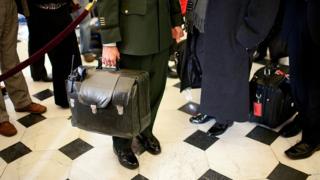 On 20 January, inauguration day in the United States, a nameless, unknown military aide will be seen accompanying President Barack Obama to the handover ceremony at the US Capitol in Washington.
On 20 January, inauguration day in the United States, a nameless, unknown military aide will be seen accompanying President Barack Obama to the handover ceremony at the US Capitol in Washington.
That military aide will be carrying a satchel over his or her shoulder containing a briefcase known as « the nuclear football ». Inside will be a piece of digital hardware measuring 3in (7.3cm) by 5in, known as « the biscuit ».
This contains the launch codes for a strategic nuclear strike. The briefing for the incoming president on how to activate them will have already taken place out of public sight, but the moment President-elect Donald Trump takes the oath of office that aide, and the satchel, will move quietly over to his side.
Donald Trump will then have sole authority to order an action that could result in the deaths of millions of people in under an hour. The question on a lot of people’s minds right now is, given his thin skin and impulsive temperament, what are the safeguards, if any, to prevent an impetuous decision by one man with catastrophic consequences?
First off, it should be said that Donald Trump has rowed back on some of his earlier, provocative comments on the use of nuclear weapons. He has recently stated he would be « the last person to use them », although he has not ruled it out.
Other senior figures are also involved in the chain of command, such as the incoming US Secretary of Defence, retired US Marine Gen James Mattis, But Mark Fitzpatrick, a nuclear non-proliferation expert at the International Institute for Strategic Studies in Washington, says that ultimately, the sole authority to launch a strike rests with the president.
« There are no checks and balances on the president’s authority to launch a nuclear strike, » he says. « But between the time he authorises one and the time it’s carried out there are other people involved. »
The idea of a rogue president taking such a monumental decision on his own is unrealistic. He gives the order and the secretary of defence is constitutionally obliged to carry it out.
The secretary of defence could, in theory, refuse to obey the order if he had reason to doubt the president’s sanity, but this would constitute mutiny and the president can then fire him and assign the task to the deputy secretary of defence.
Under the 25th Amendment of the US Constitution a vice-president could, in theory, declare the president mentally incapable of taking a proper decision, but he would need to be backed by a majority of the cabinet.
So how would it work in practice?
Inside that briefcase, the « nuclear football » that never leaves the president’s side, is a « black book » of strike options for him to choose from once he has authenticated his identity as commander-in-chief, using a plastic card.
Washington folklore has it that a previous president temporarily mislaid his identification card when he left it inside a jacket that was sent to the dry cleaners.
Once the president has selected his strike options from a long-prepared « menu », the order is passed via the chairman of the Joint Chiefs of Staff to the Pentagon’s war room and then, using sealed authentication codes, on to US Strategic Command HQ in Offutt Airbase in Nebraska.
The order to fire is transmitted to the actual launch crews using encrypted codes that have to match the codes locked inside their safes.
The US and Russia both possess enough nuclear missiles to destroy each other’s cities several times over – there are reported to be 100 US nuclear warheads aimed at Moscow alone. The two countries’ arsenals account for more than 90% of the world’s total number of nuclear warheads.
As of September 2016 Russia had the most, with an estimated 1796 strategic nuclear warheads, deployed on a mixed platform of intercontinental ballistic missiles (ICBMs), submarine-launched ballistic missiles (SLBMs) and strategic bombers.
Under a programme ordered by President Vladimir Putin, Moscow has recently invested billions of roubles in upgrading its strategic nuclear missile force, keeping an arsenal of constantly mobile ballistic missiles travelling through tunnels deep beneath the forests of Siberia.
America had, in September 2016, 1,367 strategic nuclear warheads, similarly deployed in land-based underground missile silos, which by their static nature are vulnerable to a first strike, at sea onboard submarines, where they are harder to detect, and at airbases, where they can be loaded on to bombers.
The UK has about 120 strategic warheads, of which only a third are deployed at sea. The Royal Navy always keeps a portion of the nation’s Trident nuclear force somewhere in the world’s oceans, maintaining what is known as the continuous at sea deterrent.
ICBMs travel at a speed of over 17,000mph (Mach 23), flying high above the Earth’s atmosphere before descending towards their pre-programmed targets at four miles a second.
The flight-time for land-based missiles flying between Russia and the US is between 25 and 30 minutes. For submarine-based missiles, where the boats may be able to approach a coast covertly, the flight time could be considerably shorter, even as little as 12 minutes.
This does not leave a president much time to decide whether it is a false alarm or imminent Armageddon. Once ICBMs have been launched they cannot be recalled, but if they remain in their silos they will probably be destroyed by the inbound attack.
A former senior White House official told me recently that much would depend on the circumstances in which a nuclear strike was being considered.
If this was a long-term, measured policy decision to say, carry out a pre-emptive strike on country X, then a lot of people would be involved.






